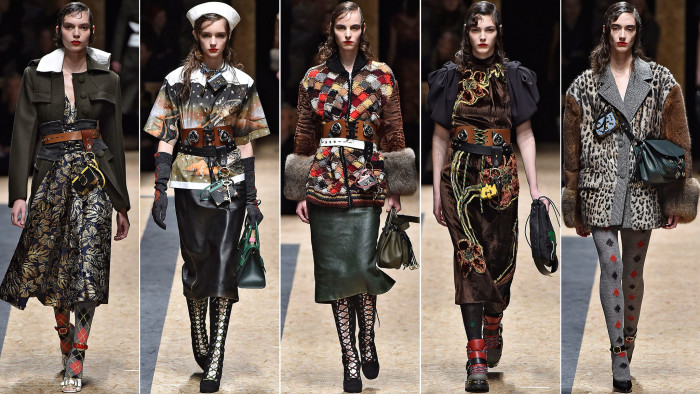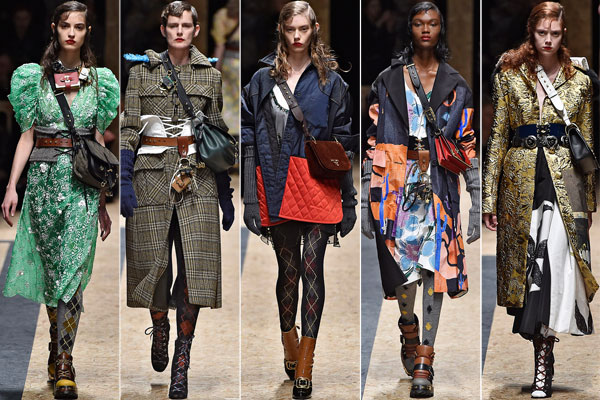Prada AW16 show report Milan Fashion Week

Simply sign up to the Life & Arts myFT Digest -- delivered directly to your inbox.
Hallelujah for a fantastic Prada show. Things have been bleak at Prada headquarters these past few seasons, even the playful Carsten Höller slide that shoots from its second floor offices has the metaphor of a downward spiral about it. Results announced last week reported a decline in annual revenues at the group for 2015, as it struggled to negotiate global currency fluctuations, tourist traffic variations and the collapse of the Asian market (the company is listed on the Hong Kong stock exchange). Group revenue at Prada, which also includes brands Miu Miu and Church’s footwear, fell to €3.545bn, from €3.552bn in 2014. After so many years of surging gains, these have been darker days.
Where Prada has traditionally been the fire at the heart of Milan Fashion Week, its potency had seemed to pall. On Thursday night, however, Miuccia Prada launched one of the most wholly satisfying womenswear collections in seasons, and a terrific riposte to critics. Her AW16 collection was rich in ideas, favourite motifs, pieces refashioned from her menswear collection last month and, essentially, lots of grabby bags: two of which, a utilitarian “Pionnière” and a more sensible “Cahier”, were available in select stores within hours of their debut.
The collection was a medley on the themes of femininity. “It’s mainly the history of women,” she said backstage. “The different dramas of women at different moments, when she’s happy, when she’s in pain, when she’s beautiful, when she’s horrible. I think we need to understand who we are now, and maybe it’s useful to look back at characteristics like love, pain and happiness in different genres of women.”

A statement corset belt laced together her “vagabond” meditation; it was cinched around Mitford-esque tweeds, Bavarian-style hunting coats, brightly printed zipper jackets and molten golden gowns, and it was often strung with smaller bag accessories and silver charms and brooches.
“The corset is the symbol of femininity, of empowerment and objectification,” she said of its connective threads. “She can be a peasant, she can be sexy, she can be nobility.” Sometimes the corsets were hung like tool belts, to add a workman-like kick to her sailor hats, woollen argyle stockings and sturdy mountain boots. Worn with panne velvet gowns or golden brocades and lace-up wedge-heeled boots, they lent an air of Louis Quatorze loucheness and seduction.
Mrs Prada had worked with the French artist and illustrator Christophe Chemin, who produced a capsule of prints first seen at menswear, to create a “collage of women through history”; prints included a pair of lovers in a passionate clinch; a hieroglyph-style Egyptian servant; a German Modernist student of the Lichtspiele school. There were printed words, too: including “Germinal” and “Thermidor”, the months of the French Revolutionary Calendar when it was recast in the “era of freedom” under the Republican government in 1793.
Was there a hidden message in the fact that words once used to describe the springtime, and the heat of summer, were emblazoned on a winter collection? Was Mrs Prada passing comment on the transparency of the seasons in this new global fashion climate?
She smiled that inscrutable smile (which is quite scrutable really because it means she is not going to tell you). “It’s embracing life,” she replied. “The good — and the bad.”
Photographs: Catwalking.com
Comments